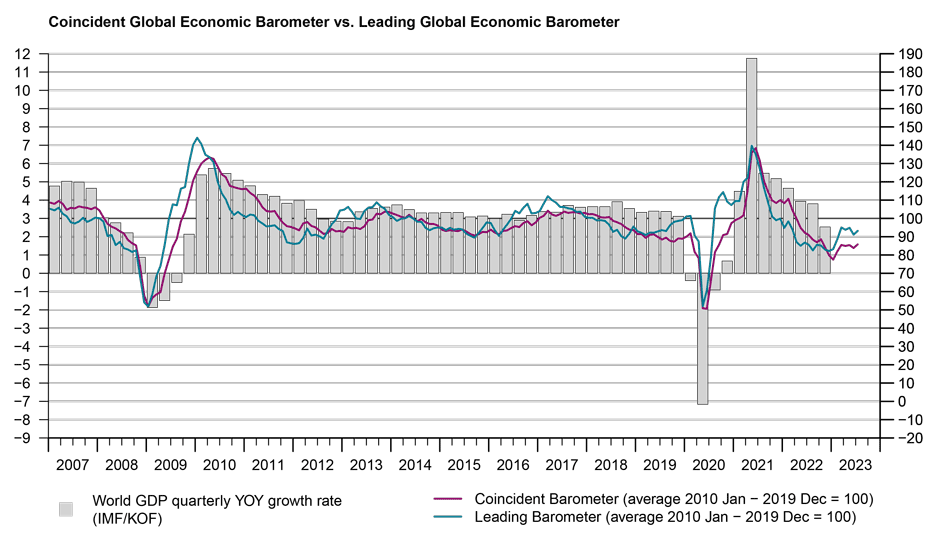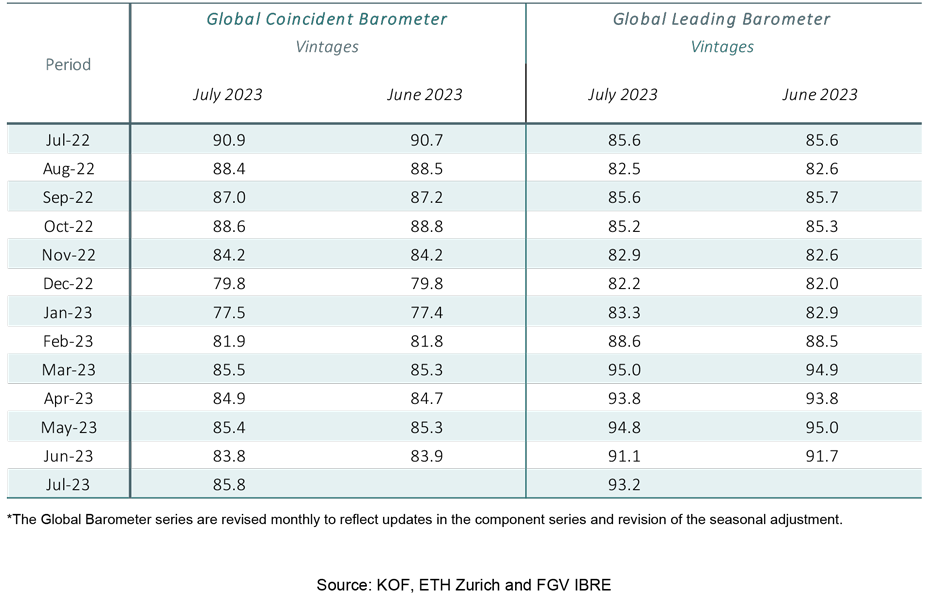Global Economic Barometers fluctuate in the adverse zone
The Global Barometers increase slightly this month, oscillating in the below-average range. This reflects the difficulties in the recovery process of world economic activity in 2023. This month’s increase occurred in all three regions analysed.

The Coincident and Leading Global Economic Barometers increase by 2.0 and 2.1 points, respectively, to 85.8 and 93.2 points in July 2023. The favorable result occurred in both time horizons of the three regions analysed. Both indicators have fluctuated in a relatively narrow range since March of this year, with the Coincident Barometer.
“The relative stability of both the coincident and leading indicators for the global economy at subdued levels suggests that the overall situation is not changing much at the moment. In addition to geopolitical tensions weighing on the investment and consumption climate, the tightening of monetary policy and the slower-than-expected recovery of the Chinese economy can at least partly explain the overall low growth momentum. Nevertheless, the leading indicator, while also subdued, continues to hover around a level well above that of the coincident indicator. At the very least, this suggests that while we are not leaving a sub-par growth environment any time soon, the outlook is brighter than the assessment of the current situation. Behind this could be falling inflation rates, indicating some form of normalization" evaluates Jan-Egbert Sturm, Co-Director of KOF Swiss Economic Institute.
“In addition to geopolitical tensions weighing on the investment and consumption climate, the tightening of monetary policy and the slower-than-expected recovery of the Chinese economy can at least partly explain the overall low growth momentum.”Jan-Egbert Sturm
Coincident Barometer – regions and sectors
In July, the Western Hemisphere made the largest positive contribution among the regions with 1.4 points, followed by the Asia, Pacific & Africa region with 0.5 points and Europe with 0.1 points. Despite this month’s increase, the level of the indicators continues to reflect a modest pace of world economic activity. This is influenced by the tightening of monetary policies in various countries to counter the recent surge in inflation and is also by the fact that the Chinese economy has so far not shown a strong rebound in growth rates and therefore has not provided a corresponding international stimulus. The graph below illustrates the contribution of each region to the deviation of the Coincident Barometer from its historical average of 100 points.
All the Coincident sector indicators increase this month, with the Construction sector recording its fourth consecutive increase and its highest level since April 2022. Despite the month’s positive results, there is also a perception of weak activity prevalent among the sectors, which remain at levels below the historical average of 100 points.
Leading Barometer – regions and sectors
The Leading Global Barometer leads the world economic growth rate cycle by an average of three to six months. In July 2023, as in the case of the Coincident Barometer, all the regions contribute positively. The Asia, Pacific & Africa region contributes 1.0 points, followed by the Western Hemisphere and Europe with 0.8 points and 0.3 points, respectively. In general, the level of the indicators points to more pessimistic expectations for economic activity in Europe and moderate expectations for economic growth in the Asia, Pacific & Africa region and the Western Hemisphere.
The Leading indicator sectors increase in July, with the exception of the indicator for the Economy (aggregated business and consumer evaluations), which falls for the second consecutive month. With this result, the indicator for Trade reaches the neutral zone and that of Construction approaches the 100 points mark.
The Global Economic Barometers
The Global Economic Barometers are a system of indicators enabling timely analysis of global economic development. They represent a collaboration between the KOF Swiss Economic Institute of the ETH Zurich in Switzerland and Fundação Getulio Vargas (FGV), based in Rio de Janeiro, Brazil. The system consists of two composite indicators, the Coincident Barometer and the Leading Barometer. The Coincident Barometer reflects the current state of economic activity, while the Leading Barometer provides a cyclical signal roughly six months ahead of current economic developments.
The two Barometers comprise the results of economic tendency surveys conducted in more than 50 countries with the aim of achieving the broadest possible global coverage. The advantages of economic tendency surveys are that their results are usually readily available and are not substantially revised after first publication.
The Coincident Barometer includes more than 1,000 different time series, while the Leading Barometer consists of over 600 time series. Cross-correlation analysis is used to decide which individual time series are included in the barometers. This involves correlating the individual time series with a reference series. The reference series used is the year-on-year growth rate of global gross domestic product (GDP), where the individual national GDPs are aggregated at purchasing power parity to form global GDP. A time series is only included in a Barometer if it shows a sufficiently high correlation and a suitable synchronization or lead with the reference series. The time period used for this correlation analysis currently runs from January 2010 to December 2019.
The series of the two Barometers are revised each month at publication and are standardized to have a mean of 100 and a standard deviation of 10 for the 10-year period previous to the most recent observations.
The methodology is described in:
Klaus Abberger, Michael Graff, Aloisio Jr. Campelo, Anna Carolina Lemos Gouveia, Oliver Müller and Jan-Egbert Sturm (2020), The Global Economic Barometers: Composite indicators for the world economy. KOF Working Papers, vol. 471, Zurich: KOF Swiss Economic Institute, ETH Zurich, 2020.
Contact
KOF Konjunkturforschungsstelle
Leonhardstrasse 21
8092
Zürich
Switzerland

